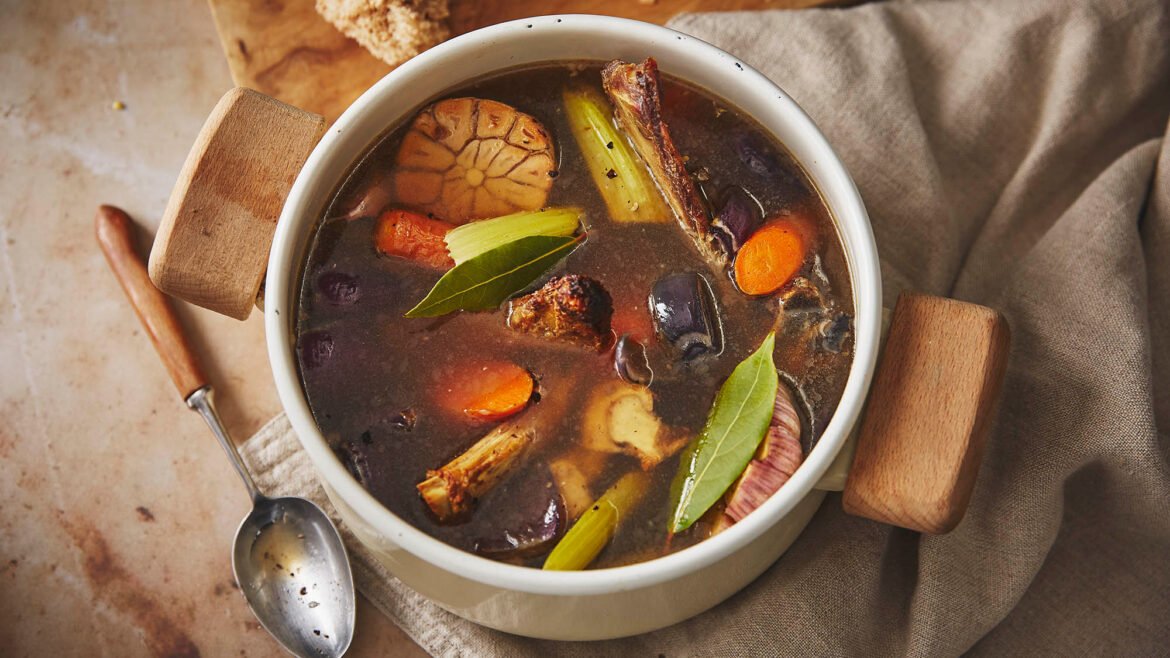Beef bone broth has become a beloved staple in kitchens worldwide for its deep flavor, nourishing properties, and versatility. Unlike a quick soup stock, this broth requires long, slow simmering to draw out the nutrients, collagen, and minerals from beef bones. The result is a rich, golden-brown liquid that serves as the foundation for countless recipes or can be sipped on its own as a warm, restorative drink.
Homemade beef bone broth is an economical and healthful alternative to store-bought broths. By controlling the ingredients, you ensure a clean, flavorful base free from artificial additives or excessive sodium. While it requires time, most of it is hands-off simmering, allowing the broth to develop its characteristic depth.
Ingredients
- 4–5 pounds beef bones (a mix of marrow bones, knuckles, oxtail, and short ribs works best)
- 2 medium onions, quartered (skins left on for color)
- 3 medium carrots, roughly chopped
- 3 celery stalks, roughly chopped
- 1 whole garlic bulb, halved horizontally
- 2 tablespoons tomato paste
- 2 bay leaves
- 10–12 whole black peppercorns
- A few sprigs of fresh thyme
- A handful of fresh parsley stems
- 2 tablespoons apple cider vinegar or red wine vinegar (helps extract minerals)
- 14–16 cups cold water
- Salt to taste (optional; many prefer seasoning later)
Instructions
- Roast the bones
Preheat your oven to 425°F (220°C). Arrange the beef bones on a baking sheet in a single layer. Roast for about 30–40 minutes, turning once, until deeply browned. This step is crucial—it develops a rich, roasted flavor and gives the broth its deep color. - Add tomato paste
About halfway through roasting, brush the bones with tomato paste. This caramelizes slightly in the oven and adds an extra layer of complexity. - Prepare the vegetables
Place the onions, carrots, celery, and garlic on the same roasting pan during the final 20 minutes. Allow them to develop some browning, which enhances the final broth. - Transfer to a stockpot
Once roasted, move the bones and vegetables into a large stockpot. Scrape any browned bits from the roasting pan into the pot as well—those little bits are packed with flavor. - Add aromatics and water
Add the bay leaves, peppercorns, thyme, parsley stems, and vinegar to the pot. Pour in 14–16 cups of cold water, making sure the bones are fully submerged. - Bring to a simmer
Slowly bring the pot to a gentle simmer over medium heat. As it heats, foam and impurities will rise to the surface. Skim these off with a ladle or spoon to keep the broth clear. Avoid boiling, as this can emulsify fat and make the broth cloudy. - Simmer low and slow
Reduce the heat to the lowest setting and let the broth gently simmer for 12–24 hours. The longer it cooks, the more nutrients and flavor are extracted. Keep the lid slightly ajar to allow steam to escape. If needed, add a little water to keep bones submerged. - Strain the broth
After simmering, carefully remove the bones with tongs and discard them. Set a large fine-mesh sieve or cheesecloth-lined colander over another pot or heatproof bowl and strain the broth. Discard the vegetables and aromatics. - Cool and store
Let the broth cool to room temperature. Refrigerate overnight. The next day, skim off the solidified fat on top (you may keep it for cooking if desired). Store the broth in airtight containers in the refrigerator for up to 5 days, or freeze for up to 3 months.
Tips for the Best Beef Bone Broth
- Choose quality bones: A mix of marrow, knuckle, and meaty bones creates a balanced broth.
- Acid matters: Always add vinegar to help draw minerals and collagen from the bones.
- Patience pays off: A minimum of 12 hours is ideal, but a full 24 hours will yield the richest results.
- Clarity: Gentle simmering and regular skimming are key to a clear, golden broth.
Uses for Beef Bone Broth
Beef bone broth is more than just a soup base. Sip it warm in a mug for a nourishing, protein-rich drink. Use it in risottos, stews, braises, and sauces for depth of flavor. Replace water with broth when cooking grains like rice, barley, or farro to enhance taste. It also serves as the backbone for hearty soups like French onion, beef barley, or vegetable beef.



